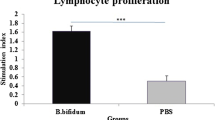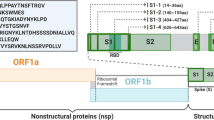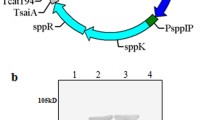Abstract
Increasing evidence shows that some probiotics can improve vaccine responses as adjuvants. This study aimed to evaluate the effect of Pediococcus pentosaceus MIANGUAN (PPM) on SARS-CoV-2 vaccine-elicited immune response in mice. Six-week-old female ICR mice were primed and boosted with SARS-CoV-2 vaccine intramuscularly at weeks 0 and 4, respectively. Mice were gavaged with PPM (5 × 109 CFU/mouse) or PBS (control) for 3 days immediately after boosting vaccination. Compared to the control, oral PPM administration resulted in significantly higher levels of RBD-specific IgG binding antibodies (> 2.3-fold) and RBD-specific IgG1 binding antibodies (> 4-fold) in the serum. Additionally, PPM-treated mice had higher titers of RBD-specific IgG binding antibodies (> 2.29-fold) and neutralization antibodies (> 1.6-fold) in the lung compared to the control mice. The transcriptional analyses showed that the B cell receptor (BCR) signaling pathway was upregulated in both splenocytes and BAL cells in the PPM group vs. the control group. In addition, the number of IFN-γ-producing splenocytes (mainly in CD4 + T cells as determined by flow cytometry) in response to restimulation of RBD peptides was significantly increased in the PPM group. RNA sequencing showed that the genes associated with T cell activation and maturation and MHC class II pathway (CD4, H2-DMa, H2-DMb1, H2-Oa, Ctss) were upregulated, suggesting that oral administration of PPM may enhance CD4 + T cell responses through MHC class II pathway. Furthermore, PPM administration could downregulate the expression level of proinflammatory genes. To conclude, oral administration of PPM could boost SARS-CoV-2 vaccine efficacy through enhancing the specific humoral and cellular immunity response and decrease the expression of inflammation pathways.






Similar content being viewed by others
Data Availability
The original contributions presented in the study are publicly available. This data can be found in the NCBI SRA database (accession numbers: PRJNA953511).
References
Xia S, Zhang Y, Wang Y, Wang H, Yang X (2020) Safety and immunogenicity of an inactivated SARS-CoV-2 vaccine, BBIBP-CorV: a randomised, double-blind, placebo-controlled, phase 1/2 trial. Lancet InfecT Dis 21. https://doi.org/10.1016/S1473-3099(20)30831-8
Xia S, Duan K, Zhang Y, Zhao D, Zhang H, Xie Z et al (2020) Effect of an inactivated vaccine against SARS-CoV-2 on safety and immunogenicity outcomes: interim analysis of 2 randomized clinical trials. Am Med Assoc. https://doi.org/10.1001/jama.2020.15543
Jackson LA, Anderson EJ, Rouphael NG, Roberts PC, Beigel JH (2020) An mRNA vaccine against SARS-COV-2 — preliminary report. N Engl J Med 383. https://doi.org/10.1056/NEJMoa2022483
Mnrd A, B A, Kje B, Alfd B, Pmf B, Dro E et al (2020) Safety and immunogenicity of ChAdOx1 nCoV-19 vaccine administered in a prime-boost regimen in young and old adults (COV002): a single-blind, randomised, controlled, phase 2/3 trial - ScienceDirect. https://doi.org/10.1016/S0140-6736(20)32466-1
Hodgson SH, Mansatta K, Mallett G, Harris V, Pollard AJ (2020) What defines an efficacious COVID-19 vaccine? A review of the challenges assessing the clinical efficacy of vaccines against SARS-CoV-2. Lancet Infect Dis 21. https://doi.org/10.1016/S1473-3099(20)30773-8
Zimmermann P, Curtis N (2019) Factors that influence the immune response to vaccination. Clin Microbiol Rev 32. https://doi.org/10.1128/cmr.00084-18
Rooks MG, Garrett WS (2016) Gut microbiota, metabolites and host immunity. Nat Rev Immunol 16:341–352. https://doi.org/10.1038/nri.2016.42
de Jong SE, Olin A, Pulendran B (2020) The impact of the microbiome on immunity to vaccination in humans. Cell Host Microbe 28:169–179. https://doi.org/10.1016/j.chom.2020.06.014
Lynn DJ, Benson SC, Lynn MA, Pulendran B (2022) Modulation of immune responses to vaccination by the microbiota: implications and potential mechanisms. Nat Rev Immunol 22:33–46. https://doi.org/10.1038/s41577-021-00554-7
Wieërs G, Belkhir L, Enaud R, Leclercq S, Philippart de Foy JM, Dequenne I et al (2019) How probiotics affect the microbiota. Front Cell Infect Microbiol 9:454. https://doi.org/10.3389/fcimb.2019.00454
Fuller R (1989) Probiotics in man and animals. J Appl Bacteriol 66:365–378
Vitetta L, Saltzman ET, Thomsen M, Nikov T, Hall S (2017) Adjuvant probiotics and the intestinal microbiome: enhancing vaccines and immunotherapy outcomes. Vaccines (Basel) 5. https://doi.org/10.3390/vaccines5040050
Yakabe K, Uchiyama J, Akiyama M, Kim YG (2021) Understanding host immunity and the gut microbiota inspires the new development of vaccines and adjuvants. Pharmaceutics 13. https://doi.org/10.3390/pharmaceutics13020163
Zimmermann P, Curtis N (2018) The influence of probiotics on vaccine responses - a systematic review. Vaccine 36:207–213. https://doi.org/10.1016/j.vaccine.2017.08.069
Peroni DG, Morelli L (2021) Probiotics as adjuvants in vaccine strategy: is there more room for improvement? Vaccines (Basel) 9. https://doi.org/10.3390/vaccines9080811
Olivares M, Díaz-Ropero MP, Sierra S, Lara-Villoslada F, Fonollá J, Navas M et al (2007) Oral intake of Lactobacillus fermentum CECT5716 enhances the effects of influenza vaccination. Nutrition 23:254–260. https://doi.org/10.1016/j.nut.2007.01.004
Boge T, Rémigy M, Vaudaine S, Tanguy J, Bourdet-Sicard R, van der Werf S (2009) A probiotic fermented dairy drink improves antibody response to influenza vaccination in the elderly in two randomised controlled trials. Vaccine 27:5677–5684. https://doi.org/10.1016/j.vaccine.2009.06.094
Wen K, Liu F, Li G, Bai M, Kocher J, Yang X et al (2015) Lactobacillus rhamnosus GG dosage affects the adjuvanticity and protection against rotavirus diarrhea in gnotobiotic pigs. J Pediatr Gastroenterol Nutr 60:834–843. https://doi.org/10.1097/mpg.0000000000000694
Chattha KS, Vlasova AN, Kandasamy S, Rajashekara G, Saif LJ (2013) Divergent immunomodulating effects of probiotics on T cell responses to oral attenuated human rotavirus vaccine and virulent human rotavirus infection in a neonatal gnotobiotic piglet disease model. J Immunol 191:2446–2456. https://doi.org/10.4049/jimmunol.1300678
Xu J, Ren Z, Cao K, Li X, Yang J, Luo X et al (2021) Boosting vaccine-elicited respiratory mucosal and systemic COVID-19 immunity in mice with the oral Lactobacillus plantarum. Front Nutr 8:789242. https://doi.org/10.3389/fnut.2021.789242
de Azevedo POS, Mendonça CMN, Seibert L, Domínguez JM, Converti A, Gierus M et al (2020) Bacteriocin-like inhibitory substance of Pediococcus pentosaceus as a biopreservative for Listeria sp. control in ready-to-eat pork ham. Braz J Microbiol 51:949–56. https://doi.org/10.1007/s42770-020-00245-w
Sellamani M, Kalagatur NK, Siddaiah C, Mudili V, Krishna K, Natarajan G et al (2016) Antifungal and zearalenone inhibitory activity of Pediococcus pentosaceus isolated from dairy products on Fusarium graminearum. Front Microbiol 7:890. https://doi.org/10.3389/fmicb.2016.00890
Thirabunyanon M, Hongwittayakorn P (2013) Potential probiotic lactic acid bacteria of human origin induce antiproliferation of colon cancer cells via synergic actions in adhesion to cancer cells and short-chain fatty acid bioproduction. Appl Biochem Biotechnol 169:511–525. https://doi.org/10.1007/s12010-012-9995-y
Ayyash M, Abu-Jdayil B, Olaimat A, Esposito G, Itsaranuwat P, Osaili T et al (2020) Physicochemical, bioactive and rheological properties of an exopolysaccharide produced by a probiotic Pediococcus pentosaceus M41. Carbohydr Polym 229:115462. https://doi.org/10.1016/j.carbpol.2019.115462
Bian X, Yang L, Wu W, Lv L, Jiang X, Wang Q et al (2020) Pediococcus pentosaceus LI05 alleviates DSS-induced colitis by modulating immunological profiles, the gut microbiota and short-chain fatty acid levels in a mouse model. Microb Biotechnol 13:1228–1244. https://doi.org/10.1111/1751-7915.13583
Dong F, Xiao F, Li X, Li Y, Wang X, Yu G et al (2022) Pediococcus pentosaceus CECT 8330 protects DSS-induced colitis and regulates the intestinal microbiota and immune responses in mice. J Transl Med 20:33. https://doi.org/10.1186/s12967-022-03235-8
Zhao X, Higashikawa F, Noda M, Kawamura Y, Matoba Y, Kumagai T et al (2012) The obesity and fatty liver are reduced by plant-derived Pediococcus pentosaceus LP28 in high fat diet-induced obese mice. PLoS ONE 7:e30696. https://doi.org/10.1371/journal.pone.0030696
Higashikawa F, Noda M, Awaya T, Danshiitsoodol N, Matoba Y, Kumagai T et al (2016) Antiobesity effect of Pediococcus pentosaceus LP28 on overweight subjects: a randomized, double-blind, placebo-controlled clinical trial. Eur J Clin Nutr 70:582–587. https://doi.org/10.1038/ejcn.2016.17
Le B, Yang SH (2019) Biosorption of cadmium by potential probiotic Pediococcus pentosaceus using in vitro digestion model. Biotechnol Appl Biochem 66:673–680. https://doi.org/10.1002/bab.1783
Yang S, Gong P, Pan J, Wang N, Tong J, Wang M et al (2019) Pediococcus pentosaceus xy46 can absorb zearalenone and alleviate its toxicity to the reproductive systems of male mice. Microorganisms 7. https://doi.org/10.3390/microorganisms7080266
Jiang S, Xia J, Lv L, Wang Q, Li Y, Xu Q et al (2021) Effects of Pediococcus pentosaceus LI05 on immunity and metabolism in germ-free rats. Food Funct 12:5077–5086. https://doi.org/10.1039/d0fo02530e
Kwon HK, Jo WR, Park HJ (2018) Immune-enhancing activity of C. militaris fermented with Pediococcus pentosaceus (GRC-ON89A) in CY-induced immunosuppressed model. BMC Complement Altern Med 18:75. https://doi.org/10.1186/s12906-018-2133-9
Le B, Kim DG, Phuoc NN, Linh NTH, Yang SH (2022) Dietary supplementation with Pediococcus pentosaceus enhances the innate immune response in and promotes growth of Litopenaeus vannamei shrimp. J Fish Dis. https://doi.org/10.1111/jfd.13666
Huang JB, Wu YC, Chi SC (2014) Dietary supplementation of Pediococcus pentosaceus enhances innate immunity, physiological health and resistance to Vibrio anguillarum in orange-spotted grouper (Epinephelus coioides). Fish Shellfish Immunol 39:196–205. https://doi.org/10.1016/j.fsi.2014.05.003
Stefan KL, Kim MV, Iwasaki A, Kasper DL (2020) Commensal microbiota modulation of natural resistance to virus infection. Cell 183:1312–24.e10. https://doi.org/10.1016/j.cell.2020.10.047
Li R, Li Y, Kristiansen K, Wang J (2008) SOAP: short oligonucleotide alignment program. Bioinformatics 24:713–714. https://doi.org/10.1093/bioinformatics/btn025
Langmead B, Salzberg SL (2012) Fast gapped-read alignment with Bowtie 2. Nat Methods 9:357–359. https://doi.org/10.1038/nmeth.1923
Kim D, Langmead B, Salzberg SL (2015) HISAT: a fast spliced aligner with low memory requirements. Nat Methods 12:357–360. https://doi.org/10.1038/nmeth.3317
Li B, Dewey CN (2011) RSEM: accurate transcript quantification from RNA-Seq data with or without a reference genome. BMC Bioinformatics 12:323. https://doi.org/10.1186/1471-2105-12-323
Love MI, Huber W, Anders S (2014) Moderated estimation of fold change and dispersion for RNA-seq data with DESeq2. Genome Biol 15:550. https://doi.org/10.1186/s13059-014-0550-8
Carter R, Fearon D (1992) CD19: lowering the threshold for antigen receptor stimulation of B lymphocytes. Science 256:105–107. https://doi.org/10.1126/science.1373518
Fujimoto M, Poe JC, Jansen PJ, Sato S, Tedder TF (1999) CD19 amplifies B lymphocyte signal transduction by regulating Src-family protein tyrosine kinase activation. J Immunol 162:7088–7094
Mócsai A, Ruland J, Tybulewicz VL (2010) The SYK tyrosine kinase: a crucial player in diverse biological functions. Nat Rev Immunol 10:387–402. https://doi.org/10.1038/nri2765
Miyazaki A, Yogosawa S, Murakami A, Kitamura D (2012) Identification of CMTM7 as a transmembrane linker of BLNK and the B-cell receptor. PLoS ONE 7:e31829. https://doi.org/10.1371/journal.pone.0031829
Calamito M, Juntilla MM, Thomas M, Northrup DL, Rathmell J, Birnbaum MJ et al (2010) Akt1 and Akt2 promote peripheral B-cell maturation and survival. Blood 115:4043–4050. https://doi.org/10.1182/blood-2009-09-241638
Cheng J, Liu Y, Yan J, Zhao L, Zhou Y, Shen X et al (2022) Fumarate suppresses B-cell activation and function through direct inactivation of LYN. Nat Chem Biol 18:954–962. https://doi.org/10.1038/s41589-022-01052-0
Esensten JH, Helou YA, Chopra G, Weiss A, Bluestone JA (2016) CD28 Costimulation: from mechanism to therapy. Immunity 44:973–988. https://doi.org/10.1016/j.immuni.2016.04.020
Moingeon P, Chang HC, Wallner BP, Stebbins C, Frey AZ, Reinherz EL (1989) CD2-mediated adhesion facilitates T lymphocyte antigen recognition function. Nature 339:312–314. https://doi.org/10.1038/339312a0
Zininga T, Ramatsui L, Shonhai A (2018) Heat shock proteins as immunomodulants. Molecules 23. https://doi.org/10.3390/molecules23112846
Izda V, Jeffries MA, Sawalha AH (2021) COVID-19: a review of therapeutic strategies and vaccine candidates. Clin Immunol 222:108634. https://doi.org/10.1016/j.clim.2020.108634
Haghpanah F, Lin G, Levin SA, Klein E (2021) Analysis of the potential impact of durability, timing, and transmission blocking of COVID-19 vaccine on morbidity and mortality. EClinicalMedicine 35:100863. https://doi.org/10.1016/j.eclinm.2021.100863
Fiolet T, Kherabi Y, MacDonald CJ, Ghosn J, Peiffer-Smadja N (2022) Comparing COVID-19 vaccines for their characteristics, efficacy and effectiveness against SARS-CoV-2 and variants of concern: a narrative review. Clin Microbiol Infect 28:202–221. https://doi.org/10.1016/j.cmi.2021.10.005
Kazemifard N, Dehkohneh A, Baradaran GS (2022) Probiotics and probiotic-based vaccines: a novel approach for improving vaccine efficacy. Front Med (Lausanne) 9:940454. https://doi.org/10.3389/fmed.2022.940454
Rizzardini G, Eskesen D, Calder PC, Capetti A, Jespersen L, Clerici M (2012) Evaluation of the immune benefits of two probiotic strains Bifidobacterium animalis ssp. lactis, BB-12® and Lactobacillus paracasei ssp. paracasei, L. casei 431® in an influenza vaccination model: a randomised, double-blind, placebo-controlled study. Br J Nutr 107:876–84. https://doi.org/10.1017/s000711451100420x
Paineau D, Carcano D, Leyer G, Darquy S, Alyanakian MA, Simoneau G et al (2008) Effects of seven potential probiotic strains on specific immune responses in healthy adults: a double-blind, randomized, controlled trial. FEMS Immunol Med Microbiol 53:107–113. https://doi.org/10.1111/j.1574-695X.2008.00413.x
Khoury DS, Cromer D, Reynaldi A, Schlub TE, Wheatley AK, Juno JA et al (2021) Neutralizing antibody levels are highly predictive of immune protection from symptomatic SARS-CoV-2 infection. Nat Med 27:1205–1211. https://doi.org/10.1038/s41591-021-01377-8
Jung J, Sung H, Kim SH (2021) Covid-19 breakthrough infections in vaccinated health care workers. N Engl J Med 385:1629–1630. https://doi.org/10.1056/NEJMc2113497
Rogers TF, Zhao F, Huang D, Beutler N, Burns A, He WT et al (2020) Isolation of potent SARS-CoV-2 neutralizing antibodies and protection from disease in a small animal model. Science 369:956–963. https://doi.org/10.1126/science.abc7520
McMahan K, Yu J, Mercado NB, Loos C, Tostanoski LH, Chandrashekar A et al (2021) Correlates of protection against SARS-CoV-2 in rhesus macaques. Nature 590:630–634. https://doi.org/10.1038/s41586-020-03041-6
Zhu Z, Shukla A, Ramezani-Rad P, Apgar JR, Rickert RC (2019) The AKT isoforms 1 and 2 drive B cell fate decisions during the germinal center response. Life Sci Alliance 2. https://doi.org/10.26508/lsa.201900506
Zhao J, Zhao J, Mangalam AK, Channappanavar R, Fett C, Meyerholz DK et al (2016) Airway memory CD4(+) T cells mediate protective immunity against emerging respiratory coronaviruses. Immunity 44:1379–1391. https://doi.org/10.1016/j.immuni.2016.05.006
Moss P (2022) The T cell immune response against SARS-CoV-2. Nat Immunol 23:186–193. https://doi.org/10.1038/s41590-021-01122-w
Sekine T, Perez-Potti A, Rivera-Ballesteros O, Strålin K, Gorin JB, Olsson A et al (2020) Robust T cell immunity in convalescent individuals with asymptomatic or mild COVID-19. Cell 183:158–68.e14. https://doi.org/10.1016/j.cell.2020.08.017
Wen K, Tin C, Wang H, Yang X, Li G, Giri-Rachman E et al (2014) Probiotic Lactobacillus rhamnosus GG enhanced Th1 cellular immunity but did not affect antibody responses in a human gut microbiota transplanted neonatal gnotobiotic pig model. PLoS ONE 9:e94504. https://doi.org/10.1371/journal.pone.0094504
Regis E, Fontanella S, Lin L, Howard R, Haider S, Curtin JA et al (2021) Sex differences in innate anti-viral immune responses to respiratory viruses and in their clinical outcomes in a birth cohort study. Sci Rep 11:23741. https://doi.org/10.1038/s41598-021-03044-x
Holling TM, Schooten E, van Den Elsen PJ (2004) Function and regulation of MHC class II molecules in T-lymphocytes: of mice and men. Hum Immunol 65:282–290. https://doi.org/10.1016/j.humimm.2004.01.005
Herkel J, Jagemann B, Wiegard C, Lazaro JF, Lueth S, Kanzler S et al (2003) MHC class II-expressing hepatocytes function as antigen-presenting cells and activate specific CD4 T lymphocyutes. Hepatology 37:1079–1085. https://doi.org/10.1053/jhep.2003.50191
Franceschi C, Bonafè M, Valensin S, Olivieri F, De Luca M, Ottaviani E et al (2000) Inflamm-aging. An evolutionary perspective on immunosenescence. Ann N Y Acad Sci 908:244–54. https://doi.org/10.1111/j.1749-6632.2000.tb06651.x
Chambers ES, Akbar AN (2020) Can blocking inflammation enhance immunity during aging? J Allergy Clin Immunol 145:1323–1331. https://doi.org/10.1016/j.jaci.2020.03.016
Pereira B, Xu XN, Akbar AN (2020) Targeting inflammation and immunosenescence to improve vaccine responses in the elderly. Front Immunol 11:583019. https://doi.org/10.3389/fimmu.2020.583019
Attiq A, Yao LJ, Afzal S, Khan MA (2021) The triumvirate of NF-κB, inflammation and cytokine storm in COVID-19. Int Immunopharmacol 101:108255. https://doi.org/10.1016/j.intimp.2021.108255
Cheng Y, Sun F, Wang L, Gao M, Xie Y, Sun Y et al (2020) Virus-induced p38 MAPK activation facilitates viral infection. Theranostics 10:12223–12240. https://doi.org/10.7150/thno.50992
Acknowledgements
We thank the member of JGX and ZHR laboratory for advice and assistance during the study. We also thank Dr. Jianqing Xu and Dr. Kangli Cao from Zhongshan Hospital, Institutes of Biomedical Sciences, Shanghai Medical College, Fudan University for SARS-CoV-2 vaccine (DNA-S and AdC68-Delta-S).
Funding
This work was supported by National Key R and D Program of China (2023YFC0871200) and Research Units of Discovery of Unknown Bacteria and Function (2018RU010) to J.G.X.
Author information
Authors and Affiliations
Contributions
JGX and ZHR conceived and designed the experiments. YLC conducted animal experiments and prepared the paper. ZJC constructed screening system of immunobiotics in vitro. SML, ZHW, and CYM assisted in animal study and ELISA. GZ isolated the PPM. MSC and JY analyzed data. All authors contributed to the article and approved the submitted version.
Corresponding authors
Ethics declarations
Ethics Approval
The protocol for animal study was reviewed and approved by the Laboratory Animal Welfare and Ethics Committee of the National Institute for Communicable Disease Control and Prevention, Chinese Center for Disease Prevention and Control.
Competing Interests
The authors declare no competing interests.
Additional information
Publisher's Note
Springer Nature remains neutral with regard to jurisdictional claims in published maps and institutional affiliations.
Supplementary Information
Below is the link to the electronic supplementary material.
Rights and permissions
Springer Nature or its licensor (e.g. a society or other partner) holds exclusive rights to this article under a publishing agreement with the author(s) or other rightsholder(s); author self-archiving of the accepted manuscript version of this article is solely governed by the terms of such publishing agreement and applicable law.
About this article
Cite this article
Chen, Y., Cao, Z., Lu, S. et al. Pediococcus pentosaceus MIANGUAN Enhances the Immune Response to Vaccination in Mice. Probiotics & Antimicro. Prot. (2024). https://doi.org/10.1007/s12602-023-10205-z
Accepted:
Published:
DOI: https://doi.org/10.1007/s12602-023-10205-z




